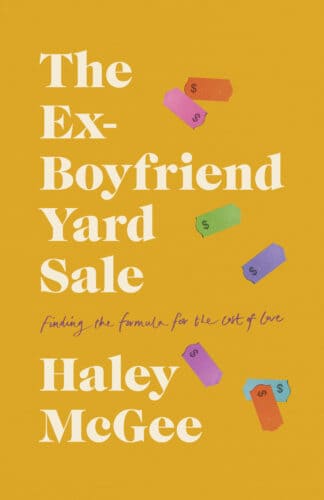“But what constitutes ‘good’ sex?” I’m holed up in a corner of the British Library, whispering animatedly with my math whiz friend.
I’d enlisted her help with my autobiographical theatre show—which would later become my book, ‘The Ex-Boyfriend Yard Sale’—about my attempt to pay off my credit card debt by selling items gifted to me by my various exes. We were in the thick of creating a mathematical formula that would take into account all the ways we invest in our romantic relationships (time, emotion, money), and spit out an accurate price for the material things we’re left with when a romance dies. A formula for the cost of love.
To create a mathematical formula, one first needs to define their data points. (Check! I had a list of 86 factors I believed to be relevant to the cost of love.) Then the task is to figure out how to quantify each one.
In honour of Valentine’s Day, which invariably thrusts us into reflection about the love we have, the love we’ve lost and the love we want, I’d like to share with you the chocolate box that appeared when a mathematician and I attempted to calculate the quality of consensual sex with a former lover.
“What do we really mean when we say the sex was good or bad?” I ask my math whiz as she scribbles notes. “A lacklustre sex life can take on many forms. In my early twenties, I was dismayed to be dating someone who wanted sex less frequently than I did. But I’ve been on the other side of that equation too, avoiding sex with a partner I deeply respected but whose love-making style left me feeling like I’d been subsumed by jellyfish.”
Undeterred, my math whiz took a breath, “Let’s examine this piece by piece. It seems that quality is one metric, but quantity also plays a role.”
We discuss this interplay while gulping down flat whites. I say, “As a relationship goes on, the desire for sex often diminishes. So even though I’m doing it fewer times per week, I’m just as satisfied with the amount.” Given this, we decide that our valuation of quantity should be based on whether you were happy with the amount of sex. And after some debate, we create the following table to assess the relationship between the quality and quantity of sex, from best to worst.
| Ranking | Quality | Quantity | Description |
| Best | High | Lots | Fulfilling sex as frequently as you like it |
| Second Best | High | Little | Pleasurable sex but not as often as you’d like it — perhaps a result of a long-distance relationship, or out-of-sync libidos |
| Third Best | Low | Little | Unfulfilling sex but not very much of it |
| Worst | Low | Lots | Lots of dissatisfying sex — may be a try-hard spirit, horny and hopeful that this time, you’ll find your groove |
Of course, satisfaction and frequency can radically change over time, so for accuracy, we decide to rate both the quality and quantity of sex, from 1-10, at the beginning, middle and end of a relationship, giving us a score out of 60.
Now buzzing with caffeine, further nuances come into focus. Another element that contributes to the value of an intimate relationship is how much new sexual territory you charted together. This could be anything from growing more comfortable in the nude to experimenting with Shibari.
As Shush Life sex educator, Evie Fehilly, says, “Sexual exploration can be an amazing way to unravel stories about ourselves as we can defy our own expectations, something that can be empowering as we take control of our own pleasure by discovering new facets of it.”
“And!” exclaims my brilliant friend. “The value of that new repertoire is compounded by how useful it is in your subsequent relationships.” We make a call to rank both the amount of new territory and its future-usefulness out of ten and multiply them together, for a score out of 100.
I notice it’s getting dark outside. Knowing we have to leave soon sends my brain into overdrive. I start talking about my first ever serious relationship. “At 22, I would have rated the quality of our sex 8/10 but, a decade later, I’d give it a 5, because I have more points of comparison now.” Our past shapes us, but our present circumstances also colour how we view the past.
We bandy around ideas as to how we might fold the effects of memory into our formula for the cost of love. My mathematician promises she’ll develop a chunk of the formula dedicated entirely to a relationship’s value in retrospect.
Leaving the British Library, we’re excited to have fundamentally shifted our thinking around the metrics of good sex. But as you can see, quantifying component parts of failed relationships comes with a myriad of complications. Primarily, my personal value system dictates how I rate elements as important and is by no means empirical. If you’re keen to start crunching numbers, please use my math as a point of departure.
If you’ve filed away a memory of a former lover as “good” or “bad”, this Valentine’s Day, why not dust off the file and take a closer look.

Haley McGee is an actor, playwright and author of The Ex-Boyfriend Yard Sale. Find her on social at @yeshaleymcgee.
The Ex-Boyfriend Yard Sale is now available wherever you buy books. The stage show version of ‘The Ex-Boyfriend Yard Sale’ was originally scheduled to open at Soulpepper Theatre this month, but due to COVID-19, the show has been postponed to the fall. Opening Night is now Friday, October 21, 2022 at 8:00PM.



 Follow Us On Instagram
Follow Us On Instagram
